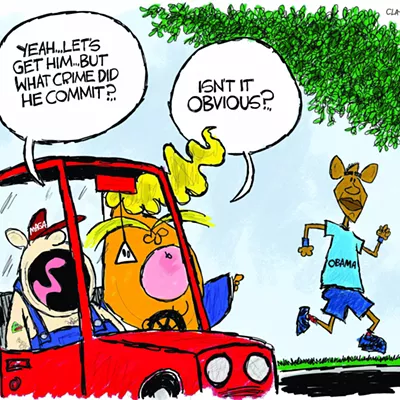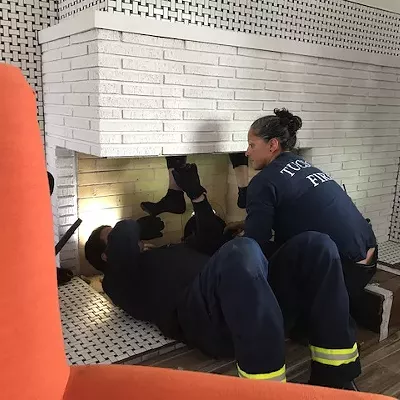Instead, the chief ranger of Organ Pipe Cactus National Monument monitors the rampant drug traffic and illegal immigration ravaging this sprawling preserve. Sharing 31 miles of international boundary with Mexico, the park's 330,000 acres of rugged bluffs and bone-dry arroyos have become a war zone. Here, the fragile desert is shredded by clandestine smuggling routes, and federal Black Hawk helicopters haunt the skies.
In a recent report, compiled by polling rangers across the country, the Fraternal Order of Police listed Organ Pipe as the most dangerous national park in the United States. Authored by the FOP-affiliated U.S. Park Rangers Lodge, the report says Organ Pipe has become "so dangerous the Park Service uses it as a training ground for tactical operations."
That training includes body armor, state-of-the-art night goggles, motion detectors and SWAT-type ranger teams toting M-16 rifles--hardly the pastoral image most American have of their national parks.
Thompson doesn't question the report's conclusions. "There is the potential for visitors to get hurt," he says. Campgrounds are sometimes targeted by cross-border thieves, and "smugglers come down these roads at 60 to 70 miles an hour. In April, one of our agents was nearly injured when a vehicle headed for Mexico side-swiped his vehicle and ripped the door off its hinges."
Environmental damage is equally disconcerting. In many places, the flimsy international fence has been torn down, making way for wildcat roads heading north into the park. Much of the desert is trampled by illegal immigrants, and backpackers hauling 60-pound marijuana cargoes.
Park Service rangers work closely with Border Patrol agents, and the agency has two representatives on the area HIDTA (High-Intensity Drug Trafficking) Group, a mish-mash of local, state and federal agencies from the county sheriff to the U.S. Customs.
IT'S RUGGED TURF, AND THE NUMBERS speak for themselves: 60,000 to 80,000 pounds of marijuana were seized in Organ Pipe last year--10,000 of that by park rangers--and nearly 1,000 illegal immigrants can pass through Organ Pipe in a single day.
Slowing his Dodge SUV to inspect fresh footprints, Thompson says rangers constantly block off new smuggling roads, but don't waste their time correcting the damage. "What's the point?" he asks. "We're in a survival mode down here. We're just trying to keep it together."
But many say Organ Pipe's plight goes far beyond its geography, and is shared by most national parks across the country--a severe shortage of law-enforcement manpower that places both visitors and rangers at risk.
Randall Kendrick, executive director of the Park Rangers Lodge, calls it a case of misplaced priorities. "In national parks, professional staffs have just mushroomed in the last 15 years," he says, "whereas the number of maintenance people and rangers have, if not declined, at least remained static. And the parks are suffering for it."
According to the International Association of Chiefs of Police, the number of commissioned park rangers fell by 9.3 percent in the latter half of the 1990s. Meanwhile, funding for park law enforcement will fall from $94 million this year to $90 million in 2002. At Organ Pipe, Thompson says his current $2.2 million budget and staff of six to eight rangers "could be doubled without looking back."
Kendrick agrees. "The parks were geared up for a family that wants to come and maybe hike a little bit," he says. "Now you're getting a different type of park user thrown into the mix. And these people go to where the border is most vulnerable."
He says public land managers on that patch of real estate face special challenges. "For example, if a rancher owns land up to the border, they're out on their property a lot. But in a park the size of Organ Pipe, with a small staff, I would say the rancher knows more about what's going on in his property than rangers who are short-staffed know what's going on in a national park."
Three more Arizona parks--Grand Canyon, Lake Mead and Saguaro West in Tucson--are included on the FOP's 10 most dangerous list. Trailing Organ Pipe only slightly is Big Bend National Park in Texas, also on the border.
While violent crime in national parks has actually decreased overall (homicides fell from 13 in 1995 to nine in 1999), those numbers don't accurately reflect hotspots like Organ Pipe or Saguaro, which the FOP report called a "home to body dumping, smuggling and poaching."
"The numbers are quite low from a national perspective," says Robert Stinson, district ranger for Saguaro's western unit. "But we're talking about a lot of parks that are isolated, and may only have one or two things happening for the entire year. Then you take others that are up against this stuff quite a bit, like me and Dale Thompson."
IT'S A DRIZZLING, MOODY SUNDAY morning, and Stinson sits at the desk in his office on Kinney Road. On the wall hangs his traditional, peaked park service hat. Panoramic photos of pristine desert flank the room. There's also a poster from the Harpers Ferry National Historical Park in West Virginia, where Stinson spent much of his childhood. Call it a family tradition: His father, recently passed away, was a ranger for 37 years.
A full-length window behind Stinson lends sweeping vistas of cloudbanks floating above the Tucson Mountains. As rooms-with-a-view go, it seems almost comforting and serene.
But two images dispel this notion.
One is Ranger Karen Bradford. Joining Stinson to talk shop, she's a small, fine-featured woman with an easygoing drawl--and a big black pistol on her belt.
Another is the bulletin board on Stinson's wall, revealing the darker side of running a modern national park. It displays mug shots of desperadoes Stinson's rangers have apprehended--from the hapless "El Tree Killer," a scruffy gent who served a jail stint for careening his car into park vegetation--to the squinty tattooed guy stopped with a load of dope. Not relishing prison, the smuggler tried slugging his way to freedom, and apparently emerged a little worse for wear; in the photo, his long hair drapes over a torn shirt. Then there's the wild-eyed woman busted for rustling saguaro ribs from the park, and for packing drugs. Despite the arrest, she was soon back on the slopes, and popped once again.
This is a park ranger's life, circa 2001.
In early days, Stinson says, rangers tucked their pistols in briefcases during daylight hours. It was a public-image thing, and a palliative to non-law enforcement staffers put off by visible fire-power.
Today, Stinson's rangers cruise the park in rugged trucks, flanked by highly visible M-16 rifles.
"Law enforcement takes quite a bit of time," Stinson says. "It takes away from time we can spend protecting (natural resources) in the park."
Bradford agrees. "I'd like to get more into the back country, to keep an eye on things. But it's hard."
The lion's share of lawbreaking in Saguaro West happens along the roads, and involves weaving drunken drivers, and smugglers of drugs and illegal aliens. Stinson says Sandario Road, slicing north through the park, is a well-known drug corridor. "Smugglers attempt to avoid the metro area," he says, adding that the FBI busted a major cocaine stash house just beyond park boundaries, following a long investigation.
Things got particularly grisly back in 1995, when a ranger chased down a suspicious vehicle. The driver tried to ram the patrol car before he was stopped, Stinson says. The officer found two bodies in the back seat.
While most of the danger in Saguaro is faced by park rangers themselves, Bradford says visitors should realize that a natural preserve so close to Tucson isn't going to be Disneyland. "Bad people come into the park, just like in the city."
STINSON SAYS THE CRITICAL FOP REPORT might help rangers by highlighting the need for more law enforcement staff and resources. Still, he questions the methodology behind the study, particularly since another Arizona flashpoint--the smuggling-plagued Coronado National Memorial near Sierra Vista--didn't make the list.
But Randall Kendrick says the memorial was omitted because "We didn't get the same type of response from them as from the other parks." And he defends the overall report, saying "There was a certain amount of self-selection. But the (FOP Rangers Lodge) president and vice-president who dealt with the comments probably have 45 years of park service law enforcement between them, and did their best to come up with a fair approximation.
"It's not a scientific survey. But each respondent is a law enforcement ranger for the park service. In a way, it (did come from three board members). Somebody has to collate this information. But the material came from park rangers."
Either way, he says the report notes special dangers faced by rangers operating in remote locales. "Most cities would not tolerate a 30-minute response time when an officer calls for help. And these problems have become more extreme in the last 10 or 15 years.
"The rank-and-file workers, they're having a hard time keeping up," Kendrick says. "We're not asking for raises. We're not asking for fancy cars. We're just asking for enough resources to leave the next generations of Americans with what we found in the national parks."
Unfortunately, budgetary relief isn't on the horizon. President Bush toured Yellowstone and other parks in late May, to unveil his "National Parks Legacy Project." The plan would address a $5 billion park maintenance backlog, but pledges no new funds for law enforcement.
Arizona Rep. Jim Kolbe, a Republican who sits on the House Interior Subcommittee, says Congress recognizes the safety needs of parks like Organ Pipe, and is helping indirectly with a 10-percent funding increase for visitor services. "Some of us on the Interior Subcommittee have argued for a long time that we need to be dealing with this backlog of unmet needs. And one of them is certainly the safety and law enforcement in many of these parks," Kolbe says.
"As I understand it, law enforcement is a sub-activity of visitors services," Kolbe continues. "And the (Park Service) could choose to tell Congress they need to allocate more of that to the law enforcement part of visitors services. More manpower is what's needed."
Then Kolbe, who has voiced opposition to the recent creation of national monuments in Arizona, adds a dose of politics: "The core of the problem is the constant battle between whether or not we spend the limited dollars that we have on acquiring new lands, or whether we do the backlog on all the maintenance and things that need to be done in existing parks."
While Park Service officials fault the FOP report as unscientific ("How do you define dangerous?" one asks), none dismiss its message. Another review of the agency prompted a "manpower deficiency request, which took into account where we are now and where we want to be in, say, five to 10 years," says Dennis Burnett, acting Park Service Chief Ranger in Washington, D.C. "The report recommended 1,295 new rangers."
Today, that report gathers dust. "No new hirings have taken place," Burnett says. "It's all driven by budget, and Congress has not allotted monies to increase our work force." Meanwhile, the current force includes a large "bubble" of rangers facing retirement within five years.
At age 58, Dale Thompson is among those planning to retire soon. But that won't change the facts on the border, he says, where too few rangers oversee far too much range. "We only touch the surface of what goes on."
THEN THERE ARE THE BODIES. An estimated 1,000 illegal immigrants may pass through Organ Pipe in a single day, not far from where 14 aliens perished in May near Yuma. Thompson says his own rangers "just recently found a man back down the road there," dead in a desert heat regularly topping 100 degrees.
Finally, there's the dismaying environmental damage. The park is simply being trashed by all the illicit traffic; wildcat roads and immigrant footpaths pummel the vegetation and threaten wildlife habitat. Thompson says his rangers have to content themselves with simply blocking off any roads they see, with little time for mitigating the destruction. "There isn't any point right now," he says.
He slows, passing yet another new road. "Haven't seen that one before," he says, pulling over for a closer inspection.
Traffic roars from a nearby Mexican highway, as he gazes up the freshly rutted smuggling route that disappears into a wash. Then he returns to his truck, and climbs in with a sigh.
The Park Service mission is to protect and preserve public lands, Thompson says. "But being on the border makes this an interesting resource to protect with a small staff and tight funding. There is a crisis down here, and it's going to take future Americans' heritage away from them."
Ranger Dale Thompson scouts a wildcat trail into Organ Pipe Cactus National Monument, at the U.S./Mexican border near Lukeville.
The desert near the parks can be deadly to illegal immigrants attempting to cross into the US: Lucian Gomez of Chiapas, age 24, gets lifted out of a Border Patrol vehicle onto a paramedic gurney. Gomez had been unconscious with a 109-degree fever, dehydrated and very close to death.
Dale Thompson surveys a battered border fence at Organ Pipe Cactus National Monument.
A trashed border fence and wildcat road lead into Organ Pipe Cactus National Monument.









